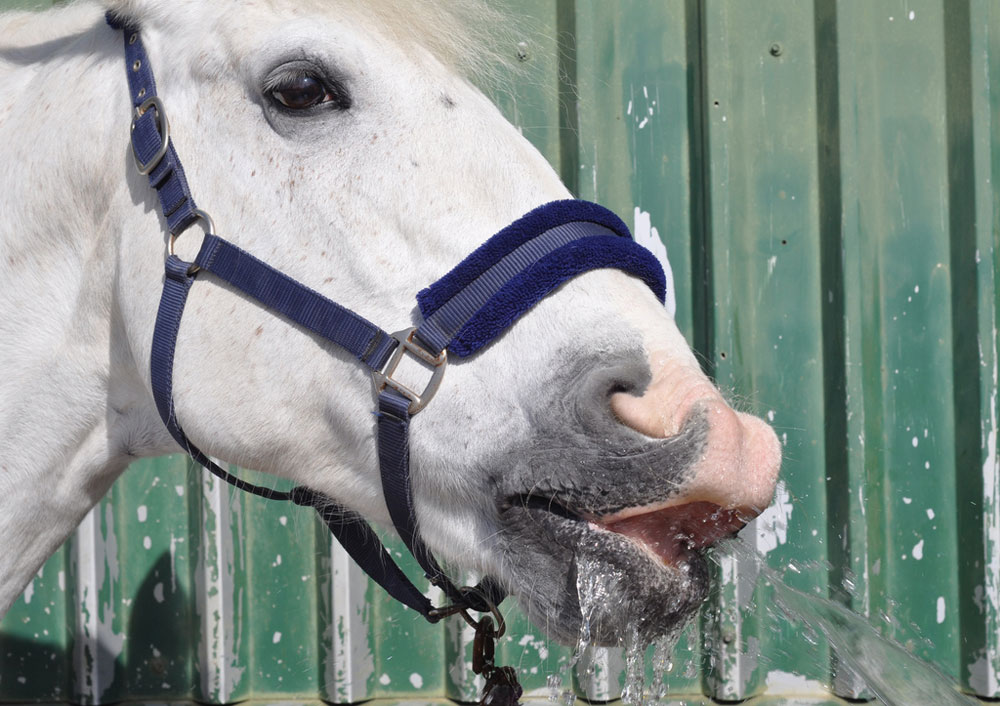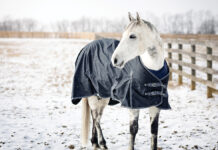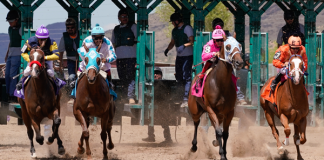It’s not hard for both you and your horse to work up a sweat while you’re riding. Learn more on how cooling out your horse is important after a ride.

Janet Johnston, DVM, an emergency and critical care veterinarian at the University of Pennsylvania School of Veterinary Medicine’s New Bolton Center, offers these six steps in cooling down your horse properly after a ride.
1. Take a walk.
First tip in cooling out your horse properly is to take a walk. Just like you warm up for your ride by walking and stretching, cool down in the same way.
“Especially if it’s hot and humid, plan for a period of time—10 to 15 minutes—at the end of your ride or training session to gradually slow the work and cool down,” says Johnston.
2. Avoid the sun.
Find a cool, shady spot to untack, whether in the barn or under a tree.
“A fan or breeze can help keep air moving to encourage [sweat] evaporation,” says Johnston. If your barn has a misting fan, that’s even better in hot weather.
3. Offer a drink.
Next tip in cooling out your horse properly is to make sure you allow him to drink water. Think about what’s in sweat—it’s water! Both you and your horse need to drink enough to replace all the water lost during the ride.
“It’s a myth that cool water will cause colic or make your horse sick,” says Johnston. “You want to encourage him to drink. Some horses will drink more water if it’s not super cold, so find a temperature that your horse enjoys. If you’re worried that he is drinking too fast, offer small amounts frequently, every few minutes, until he’s had his fill. If the work has been especially hard, a bucket of fresh water and a separate bucket with an electrolyte supplement may be helpful.”
4. Hose or sponge your horse.
If your horse is very sweaty and it’s not cold outside, a bath will feel good for your horse.
“Remove excess water with a sweat scraper, and keep applying water until the water you remove is not warm,” says Johnston. “If your horse is really hot, the water you apply will quickly absorb the heat.”
5. Use a cooler if you need to.
“Do not put on a cooler or blanket when it’s hot,” says Johnston. “Think about how you feel after hard exercise. You don’t usually want to cover up and get hotter. Horses don’t either!”
In chilly weather, your horse might benefit from a breathable wool or fleece cooler as his sweat is evaporating.
“Sheets and coolers should be used only when the horse essentially tells you he is uncomfortable,” says Johnston. “And don’t leave it on without checking his skin temperature frequently. If he feels too warm, take it off.”
6. Do some hand-grazing.
The last tip in cooling out your horse properly is to do some hand-grazing. “A little hand-walking in the shade can be beneficial,” says Johnston. “Grazing fresh grass, which is high in water content, and/or some hay is fine. Wait until he is completely cooled down to offer grain.”
Cooling Out Routine
Finding the best cool-down routine for your horse might take some time. Just like people, some horses bounce back quickly and are ready to move on with their day, while others need more care.
Coat color and fitness level matter, too. Johnston says lighter-colored horses, horses that are more fit, and smaller-framed horses will heat up slower and cool down faster.
Also be aware of your horse’s normal temperature, heart rate and respiration rate to gauge how his cool-down is going. “If they have returned close to normal, he should be cool enough to return to his stall or get turned out,” says Johnston. “Generally, it’s not necessary to take your horse’s temperature after a routine ride; however, if he continues to breathe hard and sweat and he’s not returning to normal within a half hour to an hour, it’s a good idea to take his temperature. More cooling is likely necessary, and your veterinarian may need to be contacted.”
Horses will tell you when they’re properly cooled out. “If they have seemed to have had their fill of drinking water, the skin is normal temperature—or at least no longer warm—and they aren’t sweating any more, they are likely cooled down enough,” says Johnston
Then you can bring your horse back to the barn or pasture and thank him for a good ride.
Cooling Out Your Horse – Sweat It Out
While many people think of sweat as gross, it’s actually a good thing. Janet Johnston, DVM, of the University of Pennsylvania School of Veterinary Medicine, explains how horses’ bodies produce heat when their muscles contract. “The harder they work, the more heat they are likely to produce and, in turn, need to get rid of.”
Sweating is how horses (and humans!) move heat out of their bodies. This evaporative cooling takes heat away from the skin as the sweat evaporates. A horse sweats out 70 percent of his excess heat during and after exercise. You can help your horse with this process by following a simple cool-down routine.
Winter Coat Cool-Down
If your horse gets a thick hair coat as the weather gets chilly, you may need to try additional cool-down tricks.
Your horse’s hair coat is fluffy to trap warmth against his skin. When the hair is wet and matted down, it doesn’t have air-trapping abilities. Rub sweaty spots with a towel to help them dry and bring back the coat’s fluff.
You don’t want your horse to get chilled while his coat dries, so place a cooler over him—or even just a towel over the wet area will do.
If your horse wears a blanket, don’t bundle him up again until he is cooled down and dry. Covering a wet horse in a blanket will make the sweat take longer to dry, making your horse uncomfortable and setting him up to get the chills.
This article originally appeared in the September/October 2017 issue of Young Rider magazine. Click here to subscribe!





